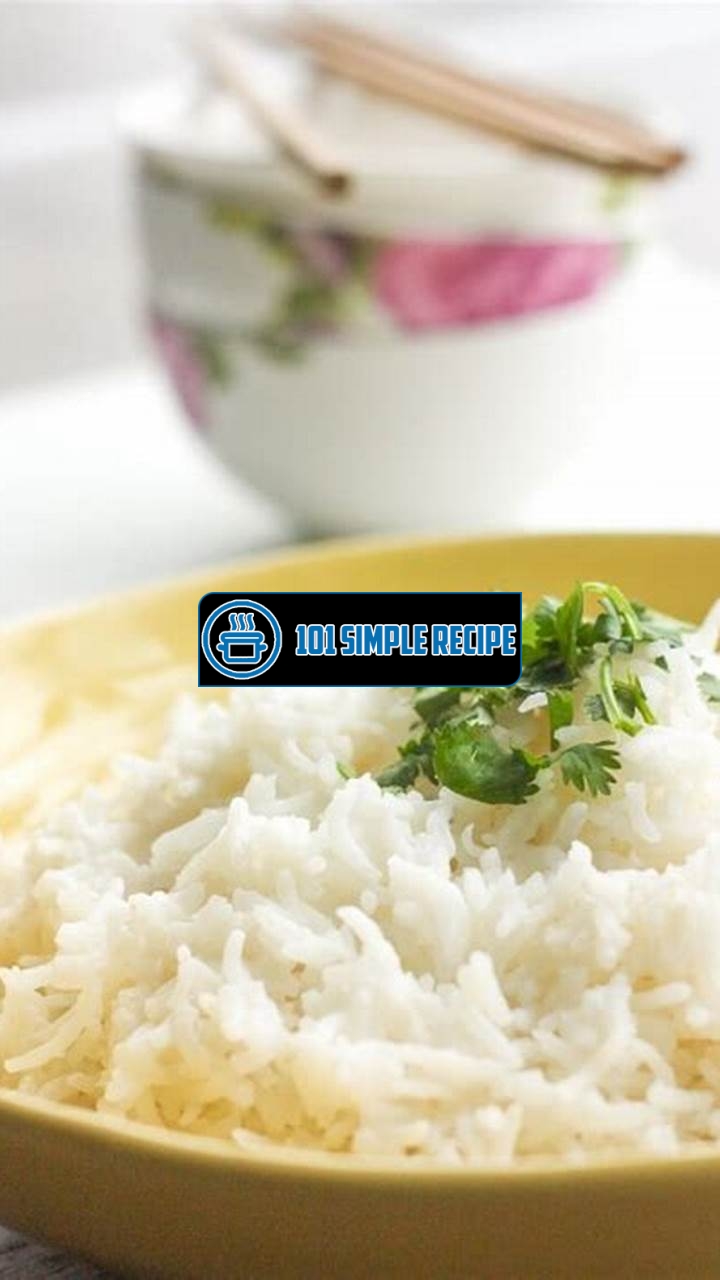Are you looking to add some tropical flavors to your dinner table? Look no further than this deliciously fragrant coconut rice recipe. With just a few simple ingredients, you can create a dish that is both aromatic and satisfying. Whether you’re planning a special dinner or just want to spice up your weeknight meals, this coconut rice recipe is sure to impress. The combination of fluffy rice, creamy coconut milk, and a hint of fragrant spices will transport you to a tropical paradise with every bite. So grab your apron and get ready to embark on a culinary journey that will tantalize your taste buds. ️

Introduction and Background
Coconut rice is a delectable dish that has its roots in many countries around the world. This aromatic and flavorful rice has become a staple in various cuisines, thanks to its unique taste and fragrance. Whether you’re a fan of Asian, Caribbean, or African cuisine, chances are you’ve come across a deliciously fragrant coconut rice recipe.
Coconut rice is more than just a side dish; it holds cultural significance as well. In many countries, this dish is a symbol of celebration and is often served during important festivals and events. Its irresistible aroma adds an extra layer of pleasure to any meal, making it a memorable experience.
History of Aromatic Coconut Rice
The history of aromatic coconut rice dates back centuries ago when it was first discovered in Southeast Asia. It is believed that the dish originated in countries such as Indonesia, Thailand, and Malaysia, where coconut trees are abundant. The locals discovered a way to infuse the rich and creamy taste of coconut into their traditional rice dishes.
Over time, aromatic coconut rice spread to other parts of the world through trade and migration. It found its way into the culinary traditions of the Caribbean, Africa, and even parts of South America. Each region added its own unique twist to the recipe, resulting in a variety of flavors and cooking techniques.
Key Ingredients in Aromatic Coconut Rice
What sets aromatic coconut rice apart from regular rice is its special combination of ingredients. The primary ingredient, of course, is coconut milk. This creamy and luxurious liquid is extracted from freshly grated coconut meat and gives the rice its distinctive taste and fragrance.
In addition to coconut milk, other key ingredients include jasmine rice, which is known for its delicate flavor, and pandan leaves, which add a subtle and refreshing aroma to the dish. Some recipes also call for spices such as ginger, garlic, and turmeric, which enhance the overall flavor profile of the rice.
Cultural Variations of Aromatic Coconut Rice
Across various cultures, aromatic coconut rice is prepared and enjoyed in different ways. In Southeast Asia, it is often seasoned with lemongrass and served alongside spicy curries or grilled meats. In the Caribbean, a popular variation of coconut rice includes the addition of pigeon peas, giving it a heartier texture and flavor.
Another notable cultural variation is found in West Africa, where coconut rice is commonly flavored with ingredients such as onions, tomatoes, and assorted spices. It is typically eaten with stews or grilled fish, making for a satisfying and well-balanced meal.
The versatility of aromatic coconut rice allows it to be adapted to various dietary preferences and restrictions. Whether you’re a vegetarian, vegan, or follow a gluten-free diet, there are countless recipes available that cater to specific needs.
In conclusion, aromatic coconut rice is a culinary delight with a rich history and cultural significance. Its delicious taste and inviting fragrance have made it a beloved dish in many countries. Whether you try a traditional recipe or put your own unique spin on it, one thing is for certain – coconut rice is an experience worth savoring.
This white castle recipe makes for a great side dish to serve with aromatic coconut rice.
Benefits of Aromatic Coconut Rice
Uncover the health benefits and nutritional advantages of including aromatic coconut rice in your diet.
Rich in Essential Nutrients
Explore the key nutrients found in aromatic coconut rice and how they contribute to a balanced diet.
Aromatic coconut rice is not only delicious and fragrant, but it is also packed with essential nutrients that can benefit your overall health and well-being. This delightful dish is made using coconut milk, which not only adds a creamy texture but also enhances the flavor. Coconut milk is a rich source of vitamins, minerals, and healthy fats.
One of the most notable nutrients found in coconut milk is lauric acid, a type of saturated fat that has been linked to numerous health benefits. Lauric acid is known to boost the immune system, promote heart health, and aid in weight loss. It also possesses antimicrobial and antiviral properties, helping to fight off harmful bacteria and viruses in the body.
In addition to lauric acid, coconut milk contains essential minerals such as iron, magnesium, and potassium. Iron is crucial for the production of red blood cells and preventing anemia, while magnesium plays a vital role in muscle function and bone health. Potassium is essential for maintaining proper electrolyte balance and regulating blood pressure.
Furthermore, coconut milk is a great source of healthy fats, particularly medium-chain triglycerides (MCTs). MCTs are easily digested and quickly used by the body for energy, making them an excellent fuel source. They are also believed to boost metabolism and help with weight loss.
By incorporating aromatic coconut rice into your diet, you can enjoy these essential nutrients and reap their many benefits. Not only will you be indulging in a delicious and fragrant dish, but you will also be nourishing your body with valuable vitamins, minerals, and healthy fats.
Health Benefits of Coconut
Learn about the numerous health benefits associated with consuming coconut, a key ingredient in aromatic coconut rice.
Coconut is a versatile and nutritious ingredient that has been used in various culinary traditions for centuries. It not only adds a unique flavor to dishes but also offers numerous health benefits.
One of the most notable health benefits of coconut is its high content of dietary fiber. Fiber is essential for maintaining a healthy digestive system, promoting regular bowel movements, and preventing constipation. It also helps to regulate blood sugar levels, improve cholesterol levels, and promote satiety, aiding in weight management.
In addition to fiber, coconut is rich in antioxidants, which help to protect the body against oxidative stress and reduce inflammation. These antioxidants, such as phenolic compounds and vitamin C, play a crucial role in boosting the immune system and preventing chronic diseases.
Coconut also contains medium-chain triglycerides (MCTs), which have been extensively studied for their potential health benefits. MCTs are easily digested and metabolized, providing a quick source of energy for the body. They can also help to increase feelings of fullness, enhance fat burning, and improve cognitive function.
Furthermore, consuming coconut can support heart health by raising levels of good cholesterol (HDL) and lowering bad cholesterol (LDL). The presence of lauric acid, a healthy saturated fat, in coconut also contributes to its heart-protective properties.
Whether it’s consumed as coconut milk, oil, or grated, incorporating coconut into your diet can provide a wide range of health benefits. By enjoying aromatic coconut rice, you can reap the advantages of this delicious ingredient while satisfying your taste buds.
Vegan and Gluten-free Option
Discover how aromatic coconut rice can be a great choice for individuals following a vegan or gluten-free lifestyle.
For individuals following a vegan or gluten-free lifestyle, finding suitable and flavorful food options can sometimes be challenging. However, aromatic coconut rice offers a delicious and versatile choice that aligns perfectly with these dietary preferences.
Coconut-based ingredients, such as coconut milk and coconut oil, are plant-based and do not contain any animal products, making them suitable for vegans and vegetarians. By using coconut milk as the base for aromatic coconut rice, you can create a creamy and satisfying dish without the need for dairy.
In addition to being vegan-friendly, aromatic coconut rice is also naturally gluten-free. Rice, the main ingredient in this dish, does not contain gluten, making it a safe option for individuals with gluten intolerance or sensitivity. By using gluten-free soy sauce or tamari as a flavoring agent, you can ensure that your aromatic coconut rice remains free from gluten-containing ingredients.
Furthermore, aromatic coconut rice can be customized to suit individual dietary preferences and taste preferences. You can add a variety of vegetables, herbs, and spices to enhance the flavor and nutritional profile of the dish. Whether you’re following a vegan or gluten-free diet, or simply looking for a delicious and aromatic rice dish, this recipe is a fantastic choice.
Incorporate aromatic coconut rice into your diet today to enjoy its rich nutritional profile, unique flavor, and various health benefits. Whether you’re looking to boost your nutrient intake, enjoy the advantages of coconut, or follow a vegan or gluten-free lifestyle, this versatile dish is sure to satisfy your cravings and nourish your body.
Preparing Aromatic Coconut Rice
Are you ready to embark on a culinary adventure and create a mouthwatering dish that will tantalize your taste buds? Look no further than the aromatic coconut rice recipe. With its fragrant aroma and delightful texture, this recipe is sure to be a hit among your family and friends. Let’s dive into the step-by-step guide to crafting this exquisite dish.
Step-by-Step Guide to Cooking Aromatic Coconut Rice
To begin, gather all the necessary ingredients: jasmine rice, coconut milk, water, salt, and pandan leaves. Ensure that you have the right proportions for a perfectly balanced flavor. Once you have your ingredients ready, follow these steps:
- Prepare the rice: Wash the jasmine rice thoroughly until the water runs clear. This helps to remove excess starch and ensures a fluffy texture. Drain the rice well and set it aside.
- Cook the rice: In a saucepan, combine the rice, coconut milk, water, and a pinch of salt. Add pandan leaves to infuse the rice with a subtle, yet distinct flavor. Bring the mixture to a boil over medium heat, then reduce the heat to low and cover the pan. Allow the rice to simmer for about 15 minutes or until all the liquid is absorbed.
- Let it rest: Once the rice is cooked, remove the pan from the heat and let it sit, covered, for an additional 5 minutes. This resting period allows the flavors to meld and the rice to become even more aromatic.
- Fluff the rice: After the resting time, remove the lid and gently fluff the rice with a fork. This step helps to separate the grains and create a light and fluffy texture. Your aromatic coconut rice is now ready to be served!
In just a few simple steps, you have successfully prepared a delectable batch of aromatic coconut rice. Now, let’s move on to the next crucial aspect of achieving the perfect texture and fluffiness.
Tips for Achieving Perfect Texture and Fluffiness
Creating the ideal texture and fluffiness in your coconut rice is an art form. Here are some essential tips and tricks to help you master this crucial aspect:
- Perfect rice-to-liquid ratio: To ensure a fluffy outcome, maintain a 1:1 ratio of rice to liquid. In this recipe, we use a combination of coconut milk and water which adds a rich and creamy texture to the rice.
- Don’t peek: While the rice is simmering, resist the temptation to lift the lid and peek inside. Allowing the steam to escape can disrupt the cooking process and result in unevenly cooked rice.
- Let it rest: The resting time after cooking is crucial. It allows the rice to absorb any remaining moisture and results in a perfectly tender texture.
- Fluff with a fork: When it’s time to fluff the rice, always use a fork instead of a spoon. A fork gently separates the grains without mashing them together.
- Experiment with soaking: For an extra level of fluffiness, try soaking the rice in water for 30 minutes before cooking. This step can help to soften the grains and improve the overall texture.
By following these expert tips, you’ll be well on your way to achieving the perfect texture and fluffiness in your aromatic coconut rice. However, if you’re feeling adventurous and want to add a twist of flavor to your recipe, let’s explore some exciting variations.
Exploring Flavor Variations
While the traditional aromatic coconut rice recipe is already divine on its own, you can elevate its taste profile even further by incorporating creative additions and alterations. Here are some flavor variations to explore:
- Spice it up: For a kick of heat, add some chopped chili peppers or a dash of cayenne pepper to the cooking liquid. This variation adds a fiery dimension to the already aromatic dish.
- Go nutty: Enhance the nutty flavors by incorporating toasted coconut flakes or crushed roasted peanuts into the rice when fluffing. The added crunch and richness are sure to delight your palate.
- Fruit infusion: Add a tropical twist by mixing in some diced pineapple, mango, or even banana. These fruity additions create a refreshing and vibrant flavor profile that pairs perfectly with the coconut rice.
- Aromatic herbs: Experiment with aromatic herbs like lemongrass, cilantro, or mint. Finely chop the herbs and mix them into the rice after fluffing to infuse the dish with their invigorating fragrance.
- Citrus zest: Grate the zest of a lime or lemon and sprinkle it over the rice before serving. This simple addition adds a burst of citrusy freshness that complements the coconut undertones beautifully.
No matter which flavor variation you choose, be sure to taste and adjust the seasoning accordingly. With these creative additions, your aromatic coconut rice will become a truly unique and unforgettable culinary experience.
Serving and Pairing
When it comes to serving aromatic coconut rice, the options are endless. This versatile dish can be paired with a variety of delicious dishes, whether you’re looking for a simple side or an elaborate main course.
Serving Suggestions
If you’re looking for a quick and easy way to enjoy aromatic coconut rice, you can serve it as a side dish alongside your favorite protein. It pairs perfectly with grilled chicken, fish, or even tofu. The creamy and fragrant nature of the rice complements the flavors of the main dish, creating a harmonious blend of tastes.
For a more elaborate meal, consider serving aromatic coconut rice as the base for a stir-fry or curry. The rich flavors of the rice enhance the overall taste of the dish, adding depth and complexity. You can toss in some vegetables, such as bell peppers, broccoli, or carrots, to create a well-rounded and nutritious meal.
If you’re in the mood for something exotic, you can serve aromatic coconut rice with spicy dishes from different cuisines. It pairs particularly well with Indian and Thai curries, as well as Mexican dishes that feature bold flavors. The combination of the aromatic rice and the spicy dishes creates a tantalizing and unforgettable dining experience.
Pairing Aromatic Coconut Rice with Meat and Vegetables
When it comes to pairing aromatic coconut rice with meat and vegetables, there are endless possibilities. The creamy and fragrant rice acts as a perfect counterpart to the flavors and textures of different proteins and veggies.
For a meaty option, you can pair aromatic coconut rice with succulent grilled shrimp. The sweetness of the shrimp and the creaminess of the rice create a delightful contrast that will leave your taste buds wanting more. You can also try pairing the rice with tender beef or juicy chicken for a satisfying and flavorful meal.
If you’re a fan of vegetables, you can explore pairing aromatic coconut rice with a variety of options. Roasted vegetables, such as cauliflower, Brussels sprouts, or sweet potatoes, provide a crispy and flavorful companion to the rice. You can also sauté some greens, like spinach or kale, and mix them in with the rice to add a nutritional boost.
Exploring Fusion Cuisines with Aromatic Coconut Rice
If you’re feeling adventurous and want to infuse new flavors and textures into your meals, exploring fusion cuisines with aromatic coconut rice is the way to go. Fusion cuisine combines elements of different culinary traditions to create innovative and exciting dishes.
One fusion option is to mix aromatic coconut rice with Chinese flavors. You can add soy sauce, ginger, and garlic to the rice while it’s cooking to give it an Asian twist. Pair it with stir-fried vegetables and grilled teriyaki chicken for a delicious and unique meal.
Another fusion idea is to incorporate aromatic coconut rice into Mexican cuisine. You can serve it with spicy salsa, black beans, and grilled fajita-style chicken or beef. The combination of the fragrant rice and spicy Mexican flavors will transport your taste buds to a fiesta of flavors.
With aromatic coconut rice as your canvas, you have the freedom to experiment and create fusion dishes that cater to your personal preferences and tastes. Let your creativity run wild and explore the vast world of flavors that await you.
If you’re in the mood for some crunch, try these ranch oyster crackers. They’re the perfect snack to enjoy alongside your coconut rice.
Troubleshooting and FAQs
Preventing Sticky Rice
Sticky and clumpy rice is a common issue that can occur when cooking aromatic coconut rice. However, with a few simple techniques, you can prevent this pitfall and achieve perfectly fluffy rice every time.
- Rinse the rice: Before cooking the rice, it’s important to rinse it thoroughly to remove excess starch. Place the rice in a fine-mesh sieve and rinse it under cold water until the water runs clear. This will help prevent the rice from becoming sticky.
- Use the right amount of water: The ratio of water to rice is crucial in preventing sticky rice. For aromatic coconut rice, the general rule is to use 1 cup of rice to 1 ½ cups of water. Adjust the ratio slightly according to your desired texture.
- Avoid peeking: Once you’ve added the rice and water to the pot, resist the temptation to lift the lid and check on it. Opening the lid releases steam and can disrupt the cooking process, resulting in stickier rice.
- Let it rest: After cooking the rice, allow it to rest in the pot with the lid on for about 5 minutes. This gives the rice a chance to absorb any remaining moisture and separate the grains.
Remember, the key to preventing sticky rice is to rinse it well, use the proper water-to-rice ratio, avoid peeking, and let it rest before serving.
Enhancing Flavor Intensity
Aromatic coconut rice already has a delightful flavor, but there are techniques you can use to enhance its intensity and elevate your culinary experience. Here are some tips to bring out the best flavors:
- Toast the rice: Before cooking, you can toast the rice grains in a dry pan over medium heat for a few minutes. This brings out a nutty aroma and adds depth to the flavor of the rice.
- Add aromatics: Enhance the flavor of your aromatic coconut rice by adding fragrant herbs and spices. Options include lemongrass, ginger, garlic, or even a pinch of turmeric for a vibrant yellow color.
- Coconut milk infusion: Instead of using plain water, you can cook the rice in coconut milk to intensify the coconut flavor. Simply substitute part or all of the water with coconut milk for a rich and aromatic result.
- Garnish with fresh herbs: Just before serving, top your aromatic coconut rice with fresh cilantro, mint, or basil leaves. This adds a burst of freshness and complements the flavors of the dish.
By toasting the rice, adding aromatics, infusing coconut milk, and garnishing with fresh herbs, you’ll elevate the flavor of your aromatic coconut rice to new heights!
Reheating Aromatic Coconut Rice
If you have leftover aromatic coconut rice, you can easily reheat it while maintaining its taste and texture. Follow these expert tips for the best results:
- Use a steamer: The steaming method is ideal for reheating rice as it helps retain moisture. Place the rice in a heatproof dish, cover it with a lid or aluminum foil, and steam for about 5-10 minutes until heated through.
- Sprinkle with water: Before reheating, sprinkle a few drops of water over the rice to add moisture. This prevents the rice from drying out during the reheating process.
- Add a splash of coconut milk: To restore some of the coconut flavor, drizzle a small amount of coconut milk over the reheated rice. Gently mix it in to distribute the flavor evenly.
- Stir-fry with vegetables: Alternatively, you can transform your leftover aromatic coconut rice into a delicious stir-fried dish. Heat some oil in a pan, add your preferred vegetables and cooked rice, and stir-fry until heated and well combined.
Whether you choose to steam, sprinkle with water, add coconut milk, or turn it into a stir-fry, reheating aromatic coconut rice doesn’t have to be a challenge. Enjoy the flavors all over again!
Looking for a healthy recipe? Try this weight loss recipe that pairs well with coconut rice.
Frequently Asked Questions
We hope you found this article on aromatic coconut rice recipe helpful and informative. If you have any further questions or need clarification on any of the steps or ingredients, please refer to the frequently asked questions below:
| No. | Questions | Answers |
|---|---|---|
| 1. | Can I use light coconut milk? | Yes, you can use light coconut milk as a healthier alternative. However, the flavor might be slightly less rich compared to using full-fat coconut milk. |
| 2. | Can I substitute jasmine rice with basmati rice? | Absolutely! Basmati rice will work just as well and add a unique aroma to the dish. |
| 3. | Can I add vegetables to the coconut rice? | Certainly! Feel free to add your favorite vegetables such as carrots, peas, or bell peppers to make it a more substantial and nutritious meal. |
| 4. | Can I make this recipe ahead of time? | Yes, you can make the coconut rice ahead of time. Simply store it in an airtight container in the refrigerator and reheat it in the microwave or on the stovetop when ready to serve. |
| 5. | Is coconut rice vegan-friendly? | Yes, coconut rice is vegan-friendly as long as you use plant-based ingredients and avoid any animal-based toppings or additions. |
| 6. | Can I freeze leftover coconut rice? | Yes, you can freeze leftover coconut rice for up to 3 months. Make sure to store it in an airtight container or freezer bag for best results. Thaw it in the refrigerator before reheating. |
Thank You for Reading!
We hope you enjoyed learning how to make this aromatic coconut rice recipe. Remember to bookmark this page or save the link, so you can easily find it again later. Feel free to explore our website for more delicious recipes and culinary inspiration. Happy cooking!
Jump to Recipe
Aromatic Coconut Rice Recipe

Learn how to make a flavorful and aromatic coconut rice with this easy recipe. Perfect to serve as a side dish or as a base for various Asian-inspired meals.
- 2 cups jasmine rice
- 1 can (13.5 oz coconut milk)
- 1 cup water
- 1 teaspoon salt
- 2 pandan leaves (knotted (optional))
- Place the jasmine rice in a fine-mesh strainer and rinse under cold water until the water runs clear. This helps remove excess starch and prevents the rice from being sticky.
- In a medium-sized pot, combine the rinsed rice, coconut milk, water, salt, and pandan leaves (if using). Bring to a boil over medium heat. Once boiling, reduce the heat to low, cover the pot, and let simmer for 15-20 minutes or until the rice is tender and all the liquid has been absorbed.
- Remove the pot from the heat and let it sit, covered, for 5 minutes. Then, uncover the pot and use a fork to fluff the rice gently. Discard the pandan leaves. Serve the aromatic coconut rice as a delicious side dish or as a base for various Asian-inspired meals.






